Jack Iwata Collection
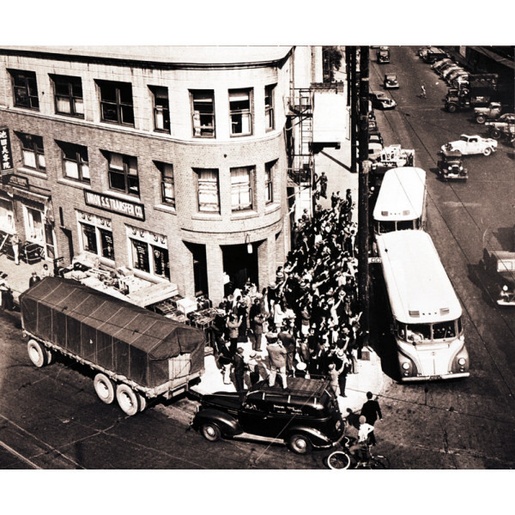
|
||
| Licensing | ||
Jack Iwata was born in Seattle, Washington, but grew up in Hiroshima Prefecture, Japan. He returned to the United States when he was 16 years old, and attended Whittier College in Whittier, California.
Jack began to work with famous photographer, Toyo Miyatake, in 1937. He continued to work with him during World War II, throughout their time together at the Manzanar concentration camp, as well as after they left the camps.
After the bombing of Pearl Harbor in 1942, Jack and his wife were forced to evacuate their home, and they were placed at the concentration camp in Manzanar, California. There, Jack continued to photograph people and places, and thus documented the activities of everyday camp life. It is because of Jack's photographs of Manzanar, and later of the Tule Lake concentration camp, that we have a glimpse into the life of a Japanese American person during World War II.
This collection features a selection of Jack's photographs from Manzanar and from Tule Lake. They showcase activities such as talent shows, mochi tsuki (making mochi), graduation ceremonies, group meetings and more. This collection shows the reality that was Manzanar, the reality that was Tule Lake. Please browse, read, reflect and remember. To see the rest of Jack Iwata's photographs, plese visit The Japanese American National Museum Web site.
Copyright is held by the Japanese American National Museum. Short-term educational use with limited circulation is permitted. For all other uses, please contact the Hirasaki National Resource Center at the Japanese American National Museum hnrc@janm.org
Slides in this album |
|
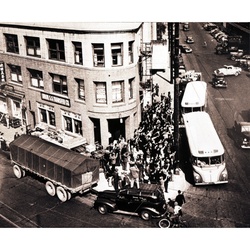
|
Jack Iwata - "Aerial perspective of crowd boarding buses in front of Nishi Hongwanji Buddhist Temple, Los Angeles, CA, 1942"Here, at the old Nishi Hongwanji Buddhist Temple in Little Tokyo, people wait to board the buses during their forced removal and incarceration. These buses took them to their respective concentration camps, where most of them remained until the end of World War II.
Jack Iwata - "Aerial perspective of crowd boarding buses in front of Nishi Hongwanji Buddhist Temple, Los Angeles, CA, 1942" |
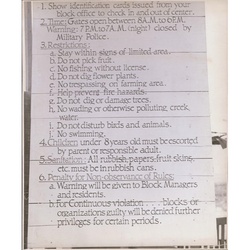
|
Jack Iwata - A List of Camp RulesThese rules were posted at Manzanar, and were expected to be abided by. One of the rules reads, "Gates open between 8am to 6pm. Warning: 7pm to 7am (night) closed by Military Police." Others read, "Stay within signs of limited area," and "Do not dig flower plants." |
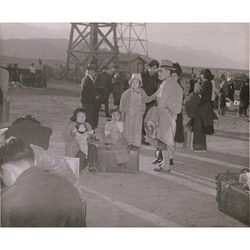
|
Jack Iwata - Arriving in ManzanarJack Iwata captured this family's incarceration experience. This was the moment they arrived in Manzanar. As you can see, they only carried one suitcase for their five-person family. |

|
Jack Iwata - Unloading MattressesWhen the incarcerated Japanese Americans arrived at their respective camps, many found towns that were either unfinished or poorly put together. This picture shows workers unloading the matresses that the prisoners were to sleep on. So, as you can see, the beds were not ready when the prisoners got off … |
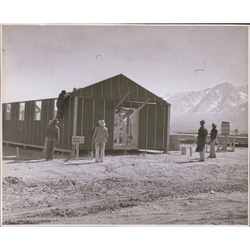
|
Jack Iwata - Building Barracks in ManzanarThis is another example of how the camps were unprepared for the arrival of the prisoners. In this picture, they are still building the actual barracks in Manzanar. |
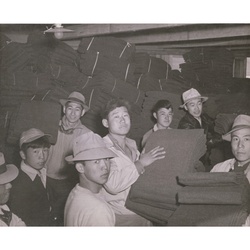
|
Jack Iwata - BlanketsIt is probable that the goods required by the prisoners were shipped to the camps in bulk. This picture of the piles and piles of blankets suggests this. Although it is unclear from the photograph which camp these were people were at, the winters were cold and windy in most …
Jack Iwata - Blankets |

|
Jack Iwata - Job Information CenterJapanese Americans at concentration camps did work. For example, many worked in the mess halls, cooking food or cleaning tables. This is a picture of the job information center at Tule Lake. It is inside a barrack. |
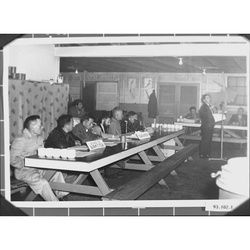
|
Jack Iwata - Union MeetingThis union meeting took place inside of a barrack at the concentration camp in Tule Lake. This picture shows the "Chairman" and the "Board of Directors." [It is not clear from the photograph what this union did or why it was meeting.] |
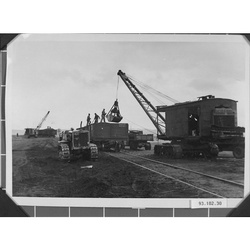
|
Jack Iwata - Coal DeliveryCoal was delivered to the camps, to be used in the home or in the kitchen. Here, a crane lifts the coal off of the train and puts it into the back of a truck. |
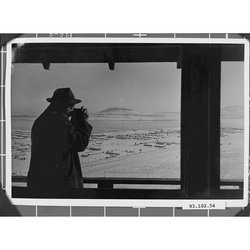
|
Jack Iwata - Robert LossHere, a man by the name of Robert Loss looks out at the Tule Lake concentration camp. Beyond Loss, you can see almost the entire camp. |
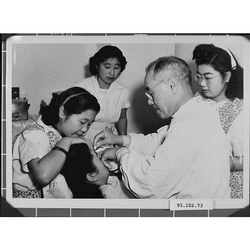
|
Jack Iwata - A DoctorAfter the bombing of Pearl Harbor, the United States government immediately began to round up "potentially dangerous" Japanese Americans, those with active leadership roles within the Japanese American community. Included in this group were educators, church leaders and doctors. Here, one of those doctors examines a camp patient.
Jack Iwata - A Doctor |
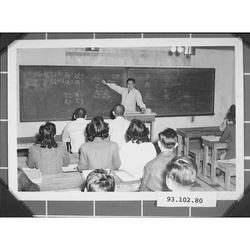
|
Jack Iwata -"Teacher and students in Japanese National Grammar School at Tule Lake concentration camp, Newell, CA, ca.1942-1945"This educator was probably one of those that were arrested immediately after the bombing of Pearl Harbor.
Jack Iwata-"Teacher and students in Japanese National Grammer School at Tule Lake concentration camp, Newell, CA, ca.1942-1945" |
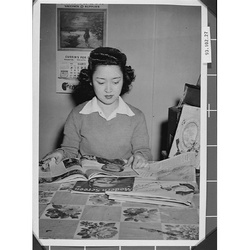
|
Jack Iwata - A Girl StudyingThis girl is probably in high school, studying for some sort of exam. Although this picture looks like a normal girl in a normal academic environment, we must not forget that she is in fact a prisoner in a concentration camp. |
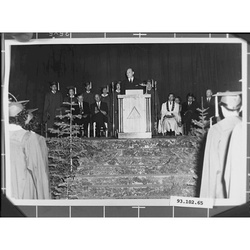
|
Jack Iwata - A Graduation CeremonyThis is a picture of a graduation ceremony in Tule Lake. The graduates are facing the stage, while a few of them sit on stage. There is a Buddhist priest on stage, as well as a man in a suit speaking at the podium. |
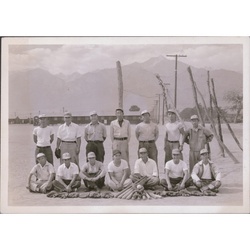
|
Jack Iwata - BaseballTo pass the time in camp, people organized themselves into various sports teams, most commonly baseball, softball and basketball teams. In this picture, the team is posed behind a pile of gloves and bats. The barracks are clearly visible behind them, reminding us of the grim reality of their situation. …
Jack Iwata - Baseball |

|
Jack Iwata - A Basketball GameThe people at camp also organized themselves into basketball teams. In fact, basketball is still very popular among Japanese American youth and adults today. This picture shows one of the ways that the prisoners tried to have some fun. |
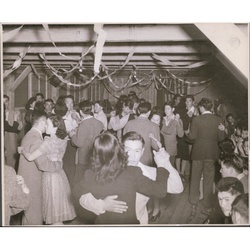
|
Jack Iwata - A Dance in ManzanarThe people in camp organized themselves in ways other than through sports teams and leagues. This school dance picture is a result of the organization of a school system. |
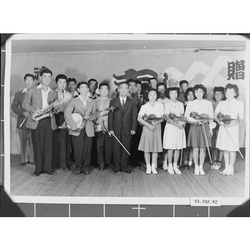
|
Jack Iwata - Tule Lake OrchestraAn orchestra was yet another way for people to get involved in their community during camp. Perhaps this orchestra played at the dance in the previous slide! |
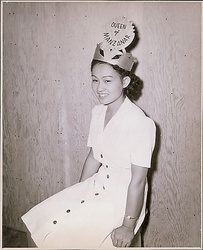
|
Jack Iwata - "Queen of Manzanar"This is one of the few pictures that has a formal title. Pictured here is Margie Midori Shimizu Hirashima, the Queen of Manzanar. Her crown was handmade. |
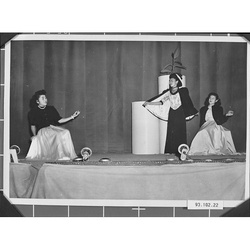
|
Jack Iwata - A Fashion ShowOften times, prisoners at camp would put on musical productions, plays or talent shows. Here, girls at the Tule Lake concentration camp put on a fashion show! |
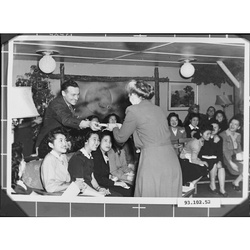
|
Jack Iwata - A Christmas PartyPeople in camp did celebrate holidays and special events. Once, a Sears truck arrived in Manzanar with a truck load of toys and gifts. This Tule Lake Christmas party took place indoors. And, from the looks of it, the party was not held in a barrack. You can see that … |
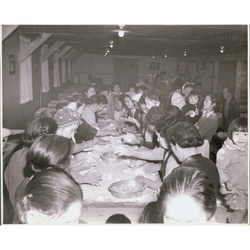
|
Jack Iwata - Mochi TsukiTraditionally, mochi is made right before the New Year celebrations, and is eaten during these celebrations. (Mochi is a pounded Japanese rice cake.) Here, the women at an unspecified concentration camp participate in "Mochi Tsuki," or making mochi. |
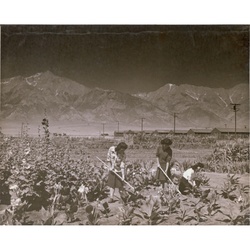
|
Jack Iwata - Women Tending GardenMany families had family gardens at the concentration camps in the United States. Here in Manzanar, two women tend to their garden. In the background, you can see the Sierra Mountains. |
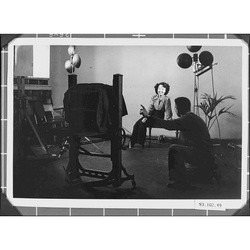
|
Jack Iwata - Photo ShootBeing a photographer, this is a scene that Jack Iwata probably saw often. Here, a young woman poses for her picture in a Tule Lake photo studio. |
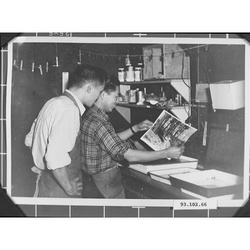
|
Jack Iwata - A Photo Developing RoomThis is also a scene that Jack would have been familiar with. He probably would have needed a place to develop his film. And, we're glad he had this place. It is what allows us to now view his work! |
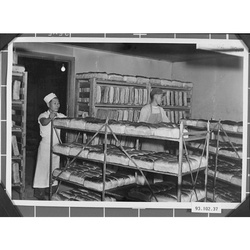
|
Jack Iwata - Pushing Bread CartsMany prisoners worked in the mess halls, performing various tasks, such as cooking, cleaning or washing dishes. This picture features two men pushing large bread carts, probably in the kitchen. I wonder whether this large quantity of bread was meant to feed everybody at the camp, or if there was … |
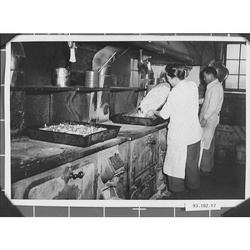
|
Jack Iwata - A Kitchen at ManzanarThis is another way in which the prisoners at camp could work at the mess halls. These two men cooked food in bulk amounts in order to feed their entire block. Each block had a kitchen. |
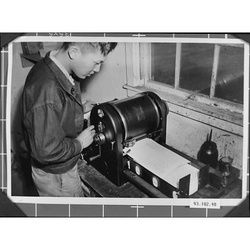
|
Jack Iwata - Mimeograph MachineThis man in Tule Lake is running off copies of the camp newspaper, "Newell Star". He used a mimeograph machine. |
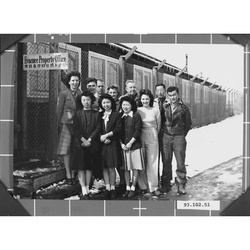
|
Jack Iwata - In Front of Evacuee Property OfficeThis group of 11 people posed outside of the Tule Lake Evacuee Property Office. It must have been during the winter, for there is snow on the ground. Jack is the person second from right.
Jack Iwata - In Front of Evacuee Property Office |
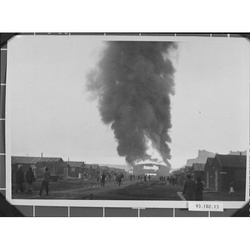
|
Jack Iwata - Fire in Tule LakeThis fire at the Tule Lake social hall broke out on New Year's Eve, 1945. There was no cause found. Barracks are visible on both sides of the hall. |

|
Jack Iwata - VaccinationsAfter World War II was over, the prisoners who chose to return to Japan had to get vaccinations. This is a picture of the vaccination process at Tule Lake. |
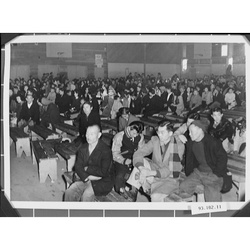
|
Jack Iwata - Back to JapanThis is the group of people from Tule Lake that chose to return to Japan after World War II ended. Here, they waited inside the social hall until they could get their registration papers that would allow them to board the boat back to Japan. |
 eishida
eishida
 UCLA Nikkei Student Union Culture Night 2008
UCLA Nikkei Student Union Culture Night 2008 The Sculpture of Ruth Asawa: Contours in the Air - Audio Tour
The Sculpture of Ruth Asawa: Contours in the Air - Audio Tour Wakatay Restaurant-Peruvian Nikkei Cuisine
Wakatay Restaurant-Peruvian Nikkei Cuisine 2007 Gardena Buddhist Church Obon
2007 Gardena Buddhist Church Obon Frank Kikuchi
Frank Kikuchi Hisako Hibi
Hisako Hibi San Jose Taiko and CAVA - 1st and Central Summer Concerts 2007
San Jose Taiko and CAVA - 1st and Central Summer Concerts 2007 2007 Higashi Honganji Buddhist Temple Obon
2007 Higashi Honganji Buddhist Temple Obon Landscaping America: Beyond the Japanese Garden - Timeline
Landscaping America: Beyond the Japanese Garden - Timeline Jack Iwata Collection
Jack Iwata Collection
 Journal feed
Journal feed
